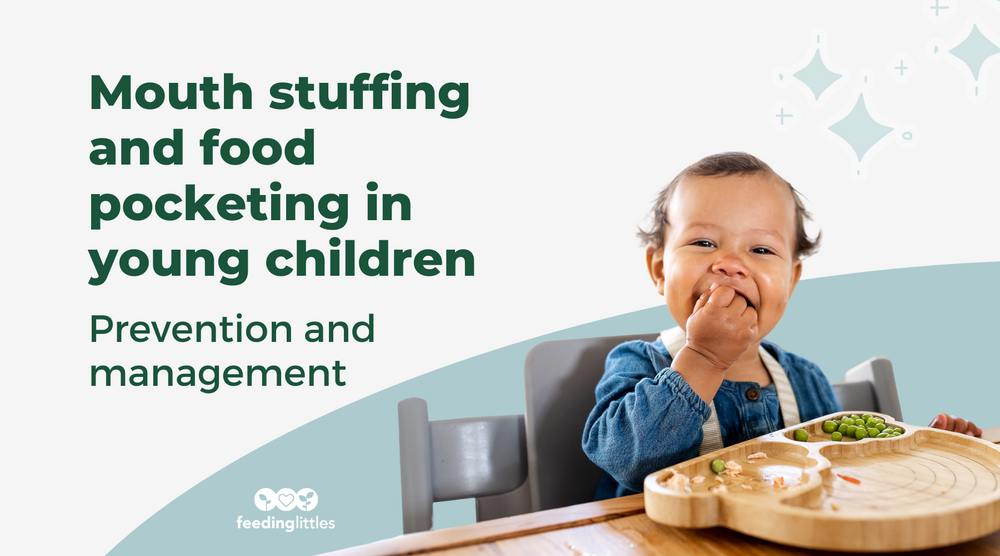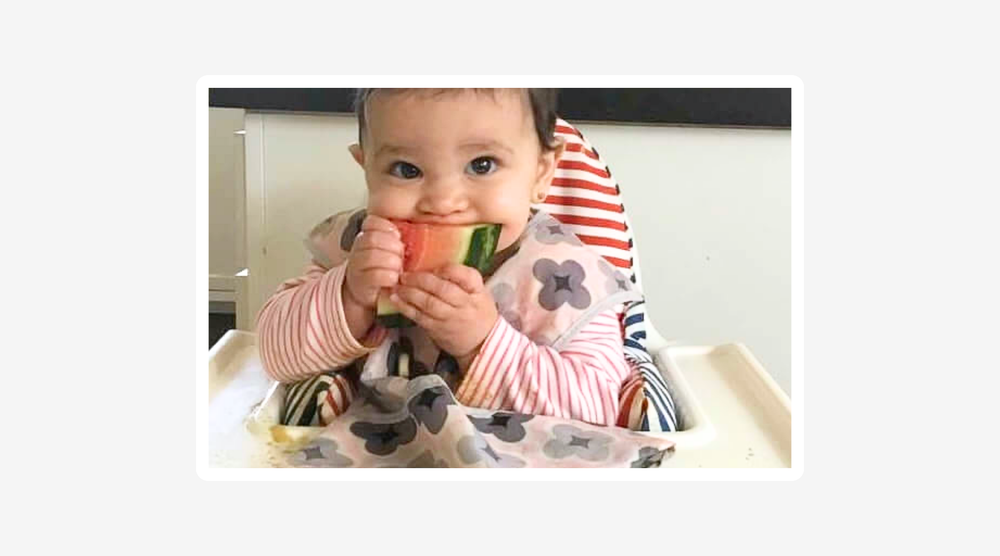
Has your baby or toddler ever filled their mouth with blueberries – one after the next – without chewing and swallowing? Perhaps they store them in their cheeks or at the roof of their mouth and you find food a few hours later!
Is this normal?
Is it behavioral?
Is this a sensory processing issue?
This question comes up almost daily in co-founder Judy's practice as an Occupational Therapist specializing in feeding therapy.
In short, food pocketing and stuffing can happen when children are eating too fast and haven’t mastered chewing skills, but if pocketing becomes a persistent issue despite using the preventive measures listed in this post, it may be time to seek professional help.
To understand why your child may pocket or overfill their mouth, let’s briefly discuss their oral development.
Note: the images used in this post were provided by parents in our Facebook Group and are used with permission. The children in these images aren’t pocketing food but rather have adorable, squishy cheeks!
Disclosure: some of the links below are affiliate links, which means (at no cost to you) we will make a small commission if you click through and make a purchase.

Mouth development and oral awareness
Starting at birth, we want your baby to learn to soothe themselves by placing their own hands into their mouth. By doing this, they learn the landscape of their mouth. This type of self-soothing with hands is comforting to babies and is exactly what we want them to do!
Your baby eventually learns how to bring toys further into their mouth and learns to gum and teethe on these safe teething toys. This is a developmental milestone that should be encouraged. They first learn where their mouth is, and then they learn about the boundaries within their mouth, such as the tongue, the hard palate and the back of their mouth.
Your baby will also learn to open and close their mouth around toys and their hands, and they soon learn that placing a toy straight back in their mouth may cause them to gag. They also learn when their mouth is too small for a large toy. In the OT world, we call this mouthing and the development of oral play skills. This is exactly what we want to see babies doing before 6 months of age.
Mouth stuffing and food
Once your child starts feeding themselves, which can happen around 6 months if you’re doing Baby-led Weaning or spoon-feeding, they may discover that they can put lots of food in their mouth. Their mouth is now bigger than it once was when they were a young baby, and they may get excited about eating new flavors and textures – so excited that they jam them all in their mouth at once. Perhaps they store them in their cheeks, chipmunk style.
What do you do?
In the case of pocketing and mouth stuffing, prevention is the best remedy.
Preventing your child from stuffing in the first place is the safest and most effective way to manage chipmunking.
How do you prevent mouth stuffing?
- Be your child’s speed bump – help them slow down their pace of eating by offering only one or two pieces of food on their tray or plate. If they’re old enough, give them the option of serving themself with small spoons, getting just one blueberry at a time.
- Offer frequent sips of water from an open cup or straw cup. Model drinking water with meals yourself. This will help your child wash down food and will slow down their pace of eating.
- Novelty utensils like animal bento picks (2-3+ years), Foodie Picks and blunt-ended toothpicks require more fine motor control and will slow their eating speed.
- If the food is a bread product, use cookie cutters to make various sizes that may feel different when they take bites. You can also try FunBites Food Cutter to cut sandwiches and other foods into bite-sized pieces.
- Older toddlers may understand taking different size bites. Ask your child to take a mouse-sized bite, then a dog-sized bite, then a dinosaur-sized bite. Work with various sizes until they understand that they can control how much food goes into their mouth by the bites they takes.
- Talk to each other at mealtimes and encourage other language skills – don’t just talk about chewing the food. Yes, sometimes we need to remind our children to chew and take sips of water, but we also want them to remember that mealtime is a positive experience. Model and imitate safe, slower eating skills and take sips of water yourself.
- Make sure that your child isn’t watching a device or TV during mealtimes, as this can promote mindless eating and can increase the risk that they’ll stuff food.
- Ask yourself if you’re pressuring your child to eat – sometimes kids stuff food in their mouths because they’re required to take a certain amount of bites (perhaps to “earn” dessert) but really don’t want to eat that food. We highly recommend taking our Toddler & Kid course to help make mealtime better without bribery or using pressure.
Your child’s mouth is already overstuffed with food – now what?
While prevention is key with overstuffing, if stuffing happens it’s critical to maneuver food out of their mouth safely.
1. Encourage your child to chew, but if they won’t ask them to spit out the food, take a sip of water, and start over.
2. Offer her a small bite as their next bite and use the strategies listed above.
3. If your child won’t spit out the food, won’t chew and swallow, and won’t drink any water, you may have to remove the food from her mouth. Be extremely careful, as you may push food further back in their mouth. Use your finger to slide food to the side and forward, not back. This may be a negative experience for your kiddo and should be only used as a last resort. This is not recommended when your baby is gagging while learning to eat and should only be used if you can clearly see the food that they won’t spit out or chew.

When should you seek help?
If you regularly find food stored in your child’s mouth minutes to hours after a meal, it may be time to seek professional help. While it can be behavioral, food stuffing may also be a red flag that your child is not chewing their food and may not be feeling the food within their mouth. A lack of oral sensation can lead to stuffing because excess food helps your child understand the boundaries of their mouth better. They may seek out crunchy or chewy textures or may crave highly flavored foods (spicy, sour) to “wake up” the oral sensations within their mouth.
This behavior is concerning to feeding professionals and may require therapy. Speak with your pediatrician and seek professional help for your child if this is a persistent problem. We recommend scheduling an assessment with a Feeding Specialist (either an Occupational Therapist {OT} or a Speech Language Pathologist {SLP}) who has specialized training in oral/mouth development.
If your child is regularly pocketing food, please always do a mouth check before they leave the table, as this can be a safety and choking concern.
We hope this helps you keep your kiddo’s mouth safe and keeps their cheeks available for sweet parent kisses, not food pocketing!
